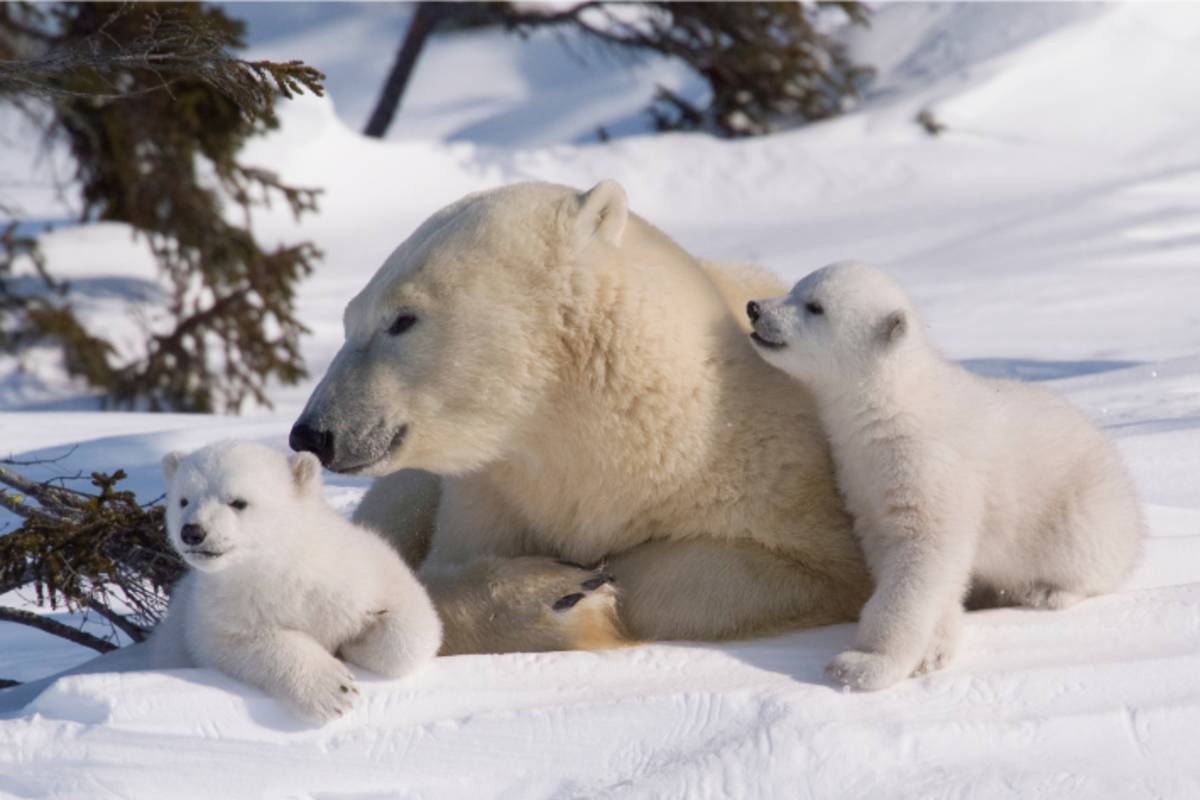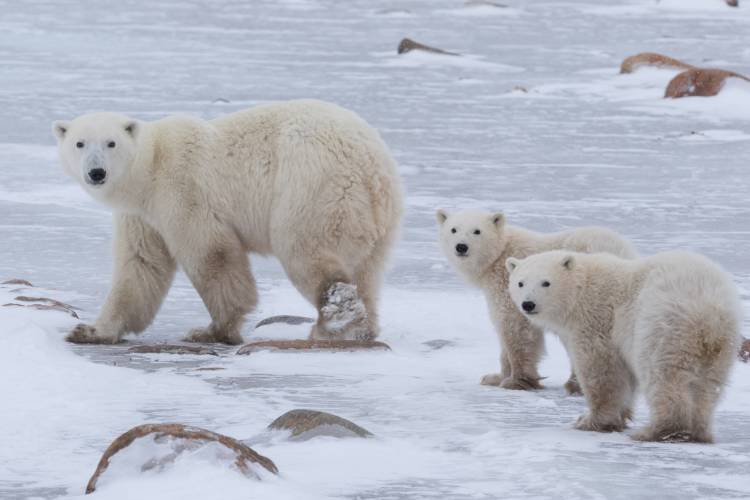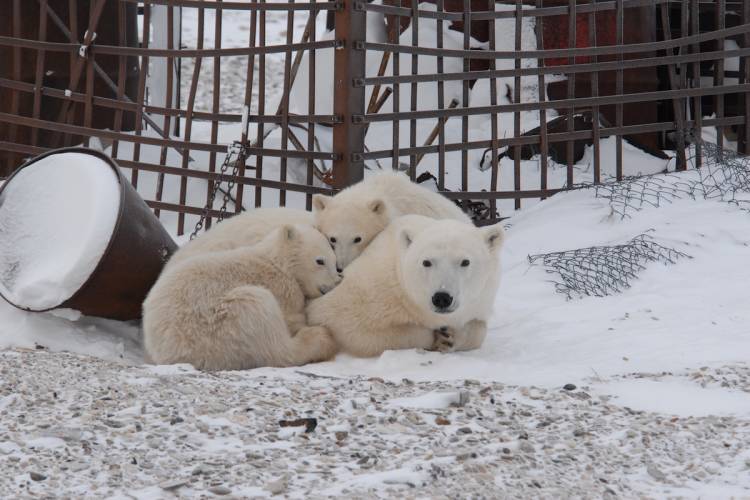Churchill, Manitoba -- February 22, 2022 -- For the 17th consecutive year, Polar Bears International (PBI), the only nonprofit organization dedicated solely to wild polar bears and their Arctic sea ice home, will host International Polar Bear Day to celebrate this special time of year when mother polar bears and their cubs are snug in their dens across the Arctic and to draw attention to the threats they face. Denning is the most vulnerable time in a polar bear’s life. And in a warming Arctic, where polar bears already face enormous challenges, the survival of every single cub is critically important. On February 27th, the group asks people to join them in taking action to protect moms and cubs now and into the future. Learn more about International Polar Bear Day here.
“A better world for polar bears is a better world for humans, too. We’re excited to unite people around the world for International Polar Bear Day, inspiring action to protect current and future generations of polar bears,” says Krista Wright, Executive Director of Polar Bears International. “Together, we can make a difference for denning families while we also work to address the impact of climate change and the future of polar bears.”
Keeping moms and cubs safe, while also addressing a warming climate, is a critical part of polar bear conservation. Loss of cubs contributed to the 40% decline of the Southern Beaufort Sea subpopulation between 2000-2010. A stable, uninterrupted denning process is essential to the survival of polar bears. Right now, scientists from Polar Bears International and partner organizations are in Svalbard, Norway, conducting research and working on den monitoring and detection technologies.
Happening Right Now with Polar Bear Research, in Svalbard, Norway:
Maternal Den Studies:
• Problem: Denning is the most critical time of a polar bear’s life, but one of the most difficult to study – a final frontier of polar bear biology.
• Solution: Researchers from Polar Bears International, the Norwegian Polar Institute, and the San Diego Zoo Wildlife Alliance are using remote, solar-powered cameras to noninvasively document key aspects of denning behavior for polar bears. They’re answering questions about the timing of den emergence, the condition of moms and cubs, and how sensitive they are to human disturbances – all helping managers and policymakers establish the best possible guidelines to protect moms and cubs.
• Get involved: Watch this video about maternal den studies.Den Detection:
• Problem: The industry’s current den-detection tool (Aerial FLIR surveys) misses 55% of dens.
• Solution: Scientists at Polar Bears International and Brigham Young University are researching a promising new technology for finding and protecting polar bear dens, called Synthetic Aperture Radar (SAR). The initial rounds of testing in Utah on artificial dens were successful, and now researchers hope to test it on real polar bear dens. This is critically important as more industry moves into the Arctic, threatening denning habitat and putting moms and cubs in harm’s way.
• Get involved: Donate to fund this new den-detection technology and watch this video about SAR.
Tune-In on Polar Bear Day:
Tune in to PBI’s live events. See the schedule of live programming during the week leading up to Polar Bear Day – and on the day itself. All ages can join to learn about moms and cubs, the threats they face, and how we can help ensure their future.
Catch the premiere of Bear Witness, a short film by The Weather Network featuring PBI scientist, Geoff York, debuting February 27 on climate.ca.
Watch this video about the PBI den-detection project. Any donations will help fund this innovative technology to protect moms and cubs.
Watch the Northern Lights Live Cam. As moms and cubs are snuggled in their dens, northern lights ripple overhead. Enjoy the Northern Lights Live Cam from explore.org and Polar Bears International, streaming from Churchill, Manitoba, Canada – polar bear capital of the world, and one of the best places on earth to view the aurora borealis.
Learn 5 facts about moms and cubs.
• For example, when polar bears are born they are blind, covered with light fur, and weigh roughly one pound–making them approximately the size of a guinea pig!
Take Action:
Donate to protect moms and cubs. This campaign funds the development of a new tool to find, and hence protect, dens hidden under the snow. By protecting dens, you'll protect cubs, helping to ensure their future.
Take the “Protect Moms and Cubs Challenge.” Want to snowball your commitment to moms and cubs? Start a “Protect Moms and Cubs Challenge” fundraiser and invite your friends, family, and colleagues to join you. PBI will reward the top 3 fundraisers with prizes!
Adopt a Polar Bear: Choose either a stuffed animal or virtual adoption.
Join the community. Sign up here to receive exclusive Arctic news to share with your community.
Spread the word with this International Polar Bear Day Toolkit. Socialize it with #PolarBearDay #ProtectMomsAndCubs #TalkAboutIt #WeSupportPolarBears
“Understanding the behavior of moms and dens is critical to safeguarding the species, especially as more industry expands into the Arctic,” says Dr. Steven C. Amstrup, Chief Scientist at Polar Bears International. “We’re thankful that the team is returning to Svalbard, Norway this season to continue critical denning research, originally spearheaded in Alaska. These findings will inform policy and technological improvements across the Arctic.”
Sea ice loss from climate change is the single biggest threat to polar bears. Most polar bears could be gone by 2100, if greenhouse gas emissions continue on their current path, due to sea ice loss. However, if we reduce emissions, most polar bear populations will survive throughout 2100. While pushing business and civic leaders to make a swift transition to renewable energy, it is also critically important to protect denning moms and cubs, preserving healthy polar bear populations for generations to come.
About Polar Bears International
Polar Bears International’s mission is to conserve polar bears and the sea ice they depend on. Through media, science, and advocacy, we work to inspire people to care about the Arctic, the threats to its future, and the connection between this remote region and our global climate. Polar Bears International is the only nonprofit organization dedicated solely to wild polar bears and Arctic sea ice, and our staff includes scientists who study wild polar bears. The organization is a recognized leader in polar bear conservation. For more information, visit www.polarbearsinternational.org.
Media Contacts
Annie Edwards, for Polar Bears International
annie@fabricmedia.net
Melissa Hourigan, for Polar Bears International
melissa@fabricmedia.net
T: 720-608-1919

















